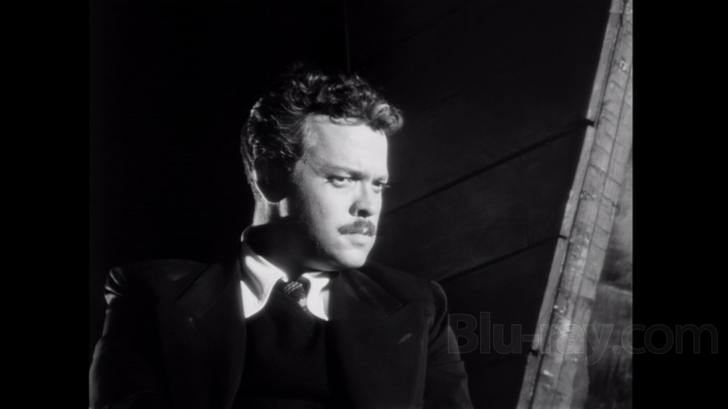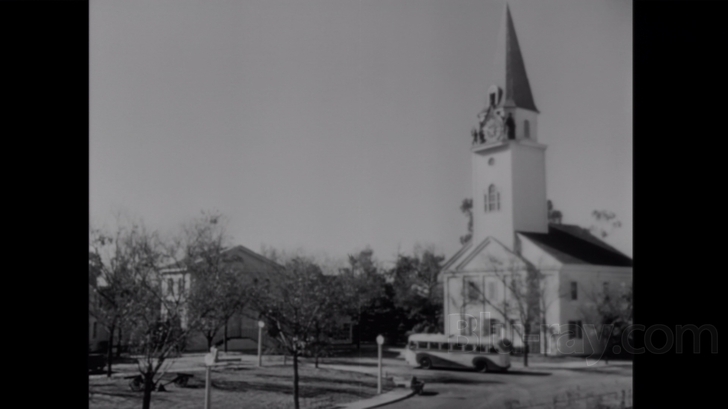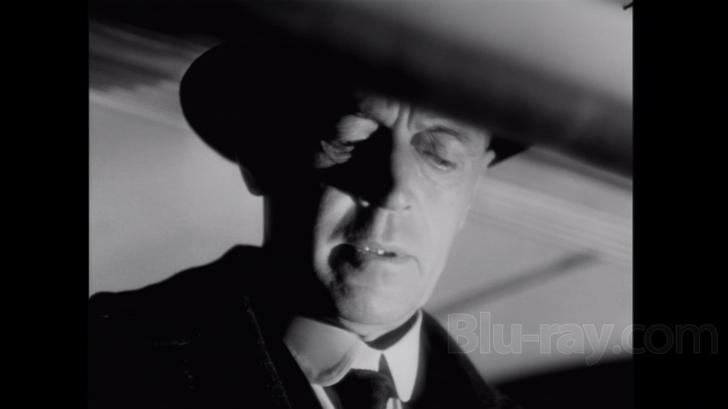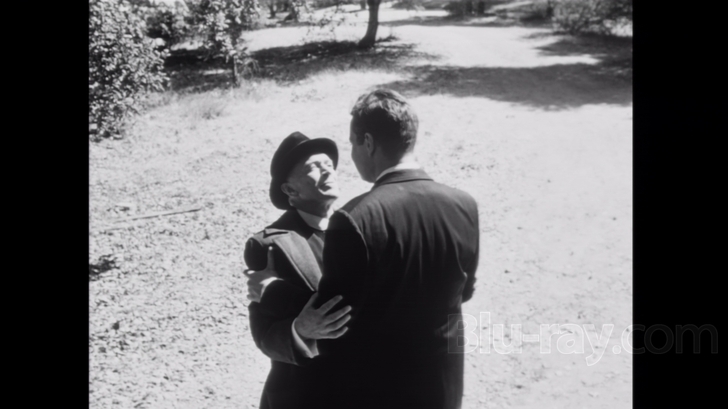The Stranger Blu-ray Movie
HomeThe Stranger Blu-ray Movie 
Blu-ray + DVDFilm Chest | 1946 | 95 min | Not rated | Feb 15, 2011
Movie rating
7.4 | / 10 |
Blu-ray rating
| Users | 2.0 | |
| Reviewer | 3.5 | |
| Overall | 2.4 |
Overview
The Stranger (1946)
Charles Rankin, a respected academic at a prominent Connecticut college seems to have the perfect life: a beautiful new wife; and a charming home in a small town that holds him in high esteem. Enter Mr. Wilson, a detective on the hunt for Nazi war criminal Franz Kindler. The appearance of Mr. Wilson threatens to reveal that underneath this idyllic veneer is a secret that could tear everything apart.
Starring: Edward G. Robinson, Loretta Young, Orson Welles, Philip Merivale, Richard LongDirector: Orson Welles
| Film-Noir | Uncertain |
| Drama | Uncertain |
| Crime | Uncertain |
| Mystery | Uncertain |
Specifications
Video
Video codec: MPEG-4 AVC
Video resolution: 1080p
Aspect ratio: 1.33:1
Original aspect ratio: 1.37:1
Audio
English: Dolby Digital 5.1
English: Dolby Digital 2.0
Subtitles
Spanish
Discs
25GB Blu-ray Disc
Two-disc set (1 BD, 1 DVD)
DVD copy
Playback
Region A, B (C untested)
Review
Rating summary
| Movie | 4.0 | |
| Video | 2.5 | |
| Audio | 2.5 | |
| Extras | 0.5 | |
| Overall | 3.5 |
The Stranger Blu-ray Movie Review
'The Stranger' has been no stranger to home video. How does this release stack up?
Reviewed by Jeffrey Kauffman February 8, 2011The immediate post-World War II era in the United States is a really fascinating little interlude to study. The horrors of the war were over physically at least, if they still created emotional scars for many. And for a couple of blissful years, the United States remained the only nuclear nation on the planet, so we hadn’t yet arrived at the increasingly manic paranoia of the Cold War and nuclear ages. We also hadn’t quite gotten into that almost schizophrenic propensity of the 1950’s, where sanguinity and fear commingled with sometimes odd results. Turning the channel of early 1950’s television brought the viewer I Love Lucy on one station and the McCarthy anti-Communist rants on another. Orson Welles’ 1946 film The Stranger is an often mesmerizing peek into the American consciousness of that era. Cast in a sort of proto- noir ambience, the film essays a pre-McCarthy era look at infiltration by “enemy combatants,” in this case a Nazi war criminal who has made it to the sylvan refuge of Connecticut and taken up life as a prep school professor. When one considers Welles’ own unabashed left wing sympathies, the film might also be seen as intentionally ironic, a slyly subversive parody of small town Americana wrapped around the focal point of an easy target, a murderous, probably half-mad, German émigré. But of course Welles’ very leftist proclivities would have been anti- fascistic if simultaneously pro-Communist, back in a time when the two “ism”’s were sharply differentiated and not as murkily joined in most peoples’ minds as they are today. This was, after all, still in an era when “Communism was cool” for the American intelligentsia highly cultured class. And in fact if anything is even slightly parodied in The Stranger, it’s the very sanguinity which would soon engulf the United States for much of the next decade, and which is referred to in the film fairly specifically with regard to a perhaps shell-shocked post-war Germany.

Just your friendly neighborhood Nazi war criminal.
Orson Welles portrays Franz Kindler, supposedly the man who invented genocide, now a fugitive living in Connecticut under the assumed name of Charles Rankin. The film actually opens with a brief prelude showing a Simon Wiesenthal like Nazi hunter named Wilson (Edward G. Robinson) who argues that the Nazi War Crimes Commission should let a prisoner “escape” so that he can lead the Commission to Kindler. That gets the film quickly to the storybook community of Harper, Connecticut, where Rankin/Kindler is about to marry Mary Longstreet (Loretta Young), daughter of a noted Judge (Adam Merivale). Rankin is tracked down by the “escaped” Nazi and quickly realizes his carefully crafted cover may soon be blown. That sets a series of events into motion that includes killings of humans and animals alike, and ultimately the threat of death against Rankin’s own new bride, Mary. Robinson’s Wilson character looks on in slowly increasing rage as he comes to realize Rankin’s real identity but doesn’t have the ability to prove his hunch.
The Stranger is in some ways the most fascinating film of Welles’ career, and, yes, that is saying a lot. The film was one of the few out and out successes in Welles’ famously turbulent directorial vocation, and it’s not hard to see why. This is a film which bristles with implied menace in the same sort of way that Hitchcock’s tonally similar Shadow of a Doubt does. What’s so amazing about the film for those of us who like to analyze or indeed over-analyze things is how seamlessly Welles manages to keep pushing the directorial envelope even as he sacrifices nothing in the way of story momentum or apt characterizations. This is a film as innovative in its own way as Citizen Kane was in terms of camera setups and framings. Over and over again Welles shoots around and literally through items that are in the foreground of the frame, as if daring the audience to look beyond the surface to the unseemly underbelly of what’s going on. Wraiths of Wilson’s pipe smoke fill the frame, while behind all sorts of interesting action unfolds. Welles shoots over the balding, out of focus head of the general store proprietor as actor Welles slowly begins to unravel at the store’s concession counter. There’s almost always something “unimportant” happening up front in setup after setup in this film, which in turn literally forces the viewer to look more deeply.
Just as bracing is the brilliantly literate script by a number of co-writers (including an uncredited John Huston and Welles himself). Though the film unfolds as a sort of mystery thriller, there’s a surprisingly nuanced look at Nazi atrocities (including the first ever feature film inclusion of concentration camp newsreel footage) and the very beginnings of a sort of international complacency that was perhaps an overreaction to the decade of horror which had just passed. The dinner table scene in The Stranger is really a marvel of political debate, as Germany’s reaction to its own post-War place in the world is examined within the confines of polite conversation.
If Loretta Young’s Mary is perhaps too naïve to ever be a fully believable character, the actress herself is so completely luminous in this film that she overcomes any passing qualms. But the film is really all about the cat and mouse game between Welles and Robinson, and neither has been finer. Welles is able to be both perfectly suave and completely menacing, often simultaneously, and his slow descent into (perhaps further) madness is riveting. Robinson is stalwart and steady, in a way quite similar to the Spencer Tracy character coming up against a different kind of evil in Bad Day at Black Rock. Robinson, like Tracy, is the unassuming all American here, nobody’s fool but not exactly the strapping hero type, either. This is a battle of wits much more than brawn.
If the film finally gives into a bit of Grand Guignol posturing at its climax, Welles is probably not to blame. As so often happened in his career, the film was taken from his control and cut to its producer’s satisfaction. (The producer, by the way, is iconic Sam Spiegel working under the name of S.P. Eagle). But as with so many Welles films wrested from his control—The Magnificent Ambersons, Touch of Evil—even the fussy hands of those who thought they knew better couldn’t completely quash the genius of the man in the director’s chair. Very few films have managed to so brilliantly meld a political thriller into such a noir (or at the very least noir-esque) format. It’s all the more amazing that the film can be enjoyed as an exciting, visceral experience by those who couldn’t care less about “film theory,” while those with a critical bent can find treasure after treasure within Welles’ homey world of Harper.
The Stranger Blu-ray Movie, Video Quality 

Let the games begin! Like a lot of public domain offerings, there was evidently no chance for new niche label Film Chest to get to an internegative or even a safety for source elements, and so this AVC encoded 1080p transfer in 1.33:1 must be judged on a slightly different scale than an archivally preserved film would be. This was sourced from a 35mm print, and if the brief restoration demonstration is any indication, Film Chest has done a very good job in cleaning this print up, rather substantially in fact. Unfortunately that clean up job has also wiped away virtually any trace of grain, and so this transfer has the same textureless appearance we got on another "restored" print of The Stranger a few years ago on DVD in the Citizen Welles set. In other regards, there are both positives and negatives to this release. The negatives are an overall soft image with overblown contrast (especially in the outdoor scenes which feature whites awfully close to blooming territory). Strangely, this overblown contrast means that black levels are frequently exceptional and that in turn means some of Welles' shadowy, dusky scenes look marvelous. And, really, there are moments in close-ups where this film looks rather impressively sharp. Is this as good as the film could have looked? Probably not. Is it horrible? No. It's too smooth and lacking in fine detail, and contrast is not what it should be, but it's clean, almost entirely free of dirt, debris and damage, and that should count for something. It boils down to whether you're a glass half full or glass half empty viewer.
The Stranger Blu-ray Movie, Audio Quality 

There are two unfortunate things about the audio on this new Blu-ray release. The first, more obvious one, is that we don't have a lossless offering, which in a film as dialogue heavy as this wouldn't be a deal breaker if it weren't for Bronislaw Kaper's gorgeous underscore, one of his most romantic and mysterious pieces. But even worse is that fact that source elements for both the Dolby tracks (5.1 and 2.0) sport some pretty bad damage at times which has not been alleviated in any discernable way. Hiss is overwhelming on at least a couple of occasions, and we also get pops, cracks, and other anomalies with surprising regularity. On at least two occasions there are also brief synchronization issues. Obviously no actual stems were available for this release, and so the 5.1 mix really seems like a bit of overkill, with little if any immersion resulting. The 2.0 track is nominally better simply because it hews more closely to the original sound design of the film, which wasn't overly aggressive to begin with. Aside from the damage, dialogue is clear and crisp and Kaper's score doesn't suffer too badly. The entire track in both its 5.1 and 2.0 incarnations sounds awfully boxy, however, with severely compressed highs and lows.
The Stranger Blu-ray Movie, Special Features and Extras 

I never count things like a Theatrical Trailer or a Restoration Demonstration as a bona fide supplement, but your mileage may vary.
The Stranger Blu-ray Movie, Overall Score and Recommendation 

The Stranger is a fascinating film for any number of reasons. Welles managed to subtly interject his directorial genius here without completely blowing himself out of the water as he did on The Magnificent Ambersons. But the film is really a prescient piece of political philosophizing, ably prophesying both the McCarthy era and that weird complacency that is part and parcel of the Eisenhower years. This Blu- ray has image and especially audio issues, but the film itself is certainly Recommended.
Similar titles
Similar titles you might also like

Jack Irish: Season 2
2018

This Gun for Hire
1942

The Blue Dahlia
1946

The Woman in the Window
1944

On Dangerous Ground
Warner Archive Collection
1951

Boomerang
1947

Appointment with Danger
1951

Trapped
Deluxe Edition
1949

I Wake Up Screaming
Hot Spot
1941

The Man Who Watched Trains Go By
The Paris Express
1952

Shield for Murder
1954

The Captive City
1952

Impact
Collector's Edition
1949

Abandoned
1949

Motherless Brooklyn
2019

Pitfall
1948

Phantom Lady
1944

Crime of Passion
1957

All My Sons
1948

Black Widow
Limited Edition to 3000
1987


